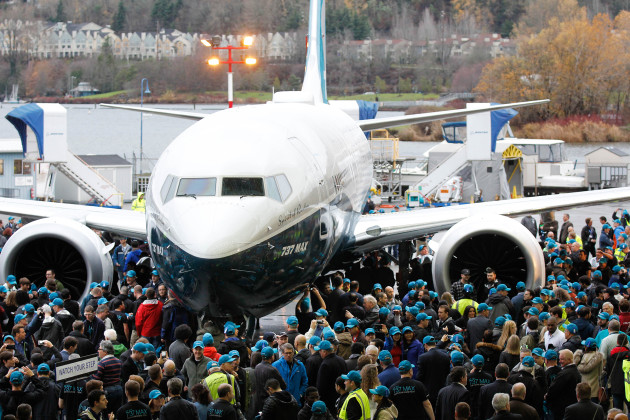 Boeing workers and VIPs surround the first 737 MAX jet to roll out in Renton, Wash., in 2015 (Credit: Boeing)
Boeing workers and VIPs surround the first 737 MAX jet to roll out in Renton, Wash., in 2015 (Credit: Boeing)
The missteps traced in “Downfall: The Case Against Boeing” — Netflix’s new documentary about Boeing’s troubled 737 MAX jet — are the stuff of Greek tragedy.
Under the direction of filmmaker Rory Kennedy, the youngest child of Robert F. Kennedy, “Downfall” recounts how the aerospace giant cut corners in a race to compete against Airbus, and pressed mightily to minimize the known problems with a computerized flight control system that was capable of causing the 737 MAX to go into a fatal dive.
The result? Not just one, but two catastrophic crashes — first in Indonesia, in 2018, and only months later in Ethiopia. The combined death toll amounted to 346 people. The jets were grounded for nearly two years while Boeing worked on a fix to the control system.
When the Indonesian crash occurred, the root cause seemed to be shrouded in uncertainty. But subsequent investigations showed that Boeing knew the cause had to do with tweaks in an automated software routine known as the Maneuvering Characteristics Augmentation System, or MCAS.
In the early stages of those investigations, I struggled to explain what MCAS was supposed to do (keep planes from stalling under extreme conditions) and what it ended up doing (forcing planes into a dive). “Downfall” uses computer graphics and re-enactments to show how MCAS and other points of failure on the 737 MAX figured in the tragedy.
The film also lays out evidence from emails and other documents showing that when the 737 MAX was undergoing certification for flight, Boeing was desperate to avoid providing pilots with extra training, at extra cost — so desperate that the company hid the MCAS software’s capabilities from pilots, airlines and regulators.
“Downfall” gives center stage to critical pilots, former FAA officials, key investigators (including U.S. Rep. Peter Defazio, D-Ore.) and the families of the victims.
Among the journalists who show up on screen are The Air Current’s Jon Ostrower, who’s based in Seattle; Andy Pasztor, who covered the controversy as The Wall Street Journal’s aerospace reporter; and KING-5 reporter Glenn Farley, who makes a cameo in news footage.
Don’t expect to see Boeing executives telling their side of the story. Instead, “Downfall” passes along Boeing’s written responses to questions at the end of the 89-minute documentary.
There’s only so much you can say in 89 minutes: Some of the other controversies that have dogged Boeing over the past couple of years — for example, production problems with the 787 Dreamliner, or glitches that have bedeviled Boeing’s Starliner space taxi — go unmentioned.
But by focusing on the 737 MAX tragedy, “Downfall” lays out a textbook case showing how hubris and greed can have deadly consequences — and tarnish the reputation of a long-respected engineering powerhouse in the process.
It’s a lesson that applies not just to Boeing or just to aerospace, but to the wider tech community as well.






